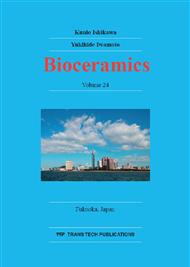[1]
N. Silva, E.A. Bonfante, R.A. Zavanelli, V.P. Thompson, J.L. Ferencz, P.G. Coelho, Reliability of Metalloceramic and Zirconia-based Ceramic Crowns, Journal of Dental Research 89 (2010) 1051-1056.
DOI: 10.1177/0022034510375826
Google Scholar
[2]
I. Clarke, M. Manaka, D. Green, P. Williams, G. Pezzotti, Y. Kim, M. Ries, N. Sugano, L. Sedel, C. Delauney, Current status of zirconia used in total hip implants, The Journal of Bone and Joint Surgery 85 (2003) 73.
DOI: 10.2106/00004623-200300004-00009
Google Scholar
[3]
M.N. Rahaman, A.H. Yao, B.S. Bal, J.P. Garino, M.D. Ries, Ceramics for prosthetic hip and knee joint replacement, J Am Ceram Soc 90 (2007) 1965-(1988).
DOI: 10.1111/j.1551-2916.2007.01725.x
Google Scholar
[4]
T. Sato, M. Shimada, Crystalline Phase Change in Yttria-Partially-Stabilized Zirconia by Low-Temperature Annealing, J Am Ceram Soc 67 (1984) C-212-C-213.
DOI: 10.1111/j.1151-2916.1984.tb19668.x
Google Scholar
[5]
M. Yoshimura, T. Noma, K. Kawabata, S. Somiya, Role of H2O on the degradation process of Y-TZP, Journal of Materials Science Letters 6 (1987) 465-467.
DOI: 10.1007/bf01756800
Google Scholar
[6]
H. -Y. Lu, H. -Y. Lin, S. -Y. Chen, Autocatalytic Effect and Microstructural Development During Ageing of 3 mol%Y203-TZP, Ceramics International 13 (1987) 207-214.
DOI: 10.1016/0272-8842(87)90064-2
Google Scholar
[7]
S. -Y. Chen, H. -Y. Lu, Sintering of 3mol %Y203-TZP and its fracture after ageing treatment, Journal of Materials Science 23 (1988) 1195-1200.
DOI: 10.1007/bf01154578
Google Scholar
[8]
E. Lilley, Review of Low Temperature Degredation in Y-TZPs, in: R.E. Tressler, M. McNallan (Eds. ), Corrosion and Corrosive Degradation of Ceramics, Am. Ceram. Soc., 1990, pp.387-407.
Google Scholar
[9]
X. Guo, On the degradation of zirconia ceramics during low-temperature annealing in water or water vapor, Journal of Physics and Chemistry of Solids 60 (1999) 539-546.
DOI: 10.1016/s0022-3697(98)00301-1
Google Scholar
[10]
S. Deville, J. Chevalier, G. Fantozzi, J.F. Bartolomé, J. Requena, J.S. Moya, R. Torrecillas, L.A. Díaz, Low-temperature ageing of zirconia-toughened alumina ceramics and its implication in biomedical implants, J Eur Ceram Soc 23 (2003).
DOI: 10.1016/s0955-2219(03)00313-3
Google Scholar
[11]
J. Chevalier, L. Gremillard, S. Deville, Low-Temperature Degradation of Zirconia and Implications for Biomedical Implants, Annual Review of Materials Research 37 (2007) 1-32.
DOI: 10.1146/annurev.matsci.37.052506.084250
Google Scholar
[12]
L. Borchers, M. Stiesch, F.W. Bach, J.C. Buhl, C. Hubsch, T. Kellner, P. Kohorst, M. Jendras, Influence of hydrothermal and mechanical conditions on the strength of zirconia, Acta Biomaterialia 6 (2010) 4547-4552.
DOI: 10.1016/j.actbio.2010.07.025
Google Scholar
[13]
M. Cattani-Lorente, S.S. Scherrer, P. Ammann, M. Jobin, H.W. Wiskott, Low temperature degradation of a Y-TZP dental ceramic, Acta Biomaterialia 7 (2011) 858-865.
DOI: 10.1016/j.actbio.2010.09.020
Google Scholar
[14]
F. Kern, 2. 75Yb-TZP Ceramics with High Strength and Aging Resistance, Journal of Ceramic Science and Technology 2 (2011) 147-154.
Google Scholar
[15]
V. Lughi, V. Sergo, Low temperature degradation -aging- of zirconia: A critical review of the relevant aspects in dentistry, Dental Materials 26 (2010) 807-820.
DOI: 10.1016/j.dental.2010.04.006
Google Scholar
[16]
F. Boulc'h, L. Dessemond, E. Djurado, Delay of tetragonal-to-monoclinic transition in water vapour due to nanostructural effect, J Eur Ceram Soc 24 (2004) 1181-1185.
DOI: 10.1016/s0955-2219(03)00563-6
Google Scholar
[17]
B. Cales, Y. Stefani, E. Lilley, Long-term in vivo and in vitro aging of a zirconia ceramic used in orthopaedy Journal of Biomedical Materials Research 28 (1994) 619-624.
DOI: 10.1002/jbm.820280512
Google Scholar
[18]
I. Thompson, R.D. Rawlings, Mechanical behaviour of zirconia and zirconia-toughened alumina in a simulated body environment, Biomaterials 11 (1990) 505-509.
DOI: 10.1016/0142-9612(90)90066-y
Google Scholar
[19]
R.A. Kimel, J.H. Adair, Aqueous Degradation and Chemical Passivation of Yttria-Tetragonally-Stabilized Zirconia at 25°C, J Am Ceram Soc 85 (2002) 1403-1408.
DOI: 10.1111/j.1151-2916.2002.tb00288.x
Google Scholar
[20]
H. Schubert, F. Frey, Stability of Y-TZP during hydrothermal treatment: neutron experiments and stability considerations, J Eur Ceram Soc 25 (2005) 1597-1602.
DOI: 10.1016/j.jeurceramsoc.2004.03.025
Google Scholar
[21]
I.L. Denry, J.A. Holloway, Microstructural and crystallographic surface changes after grinding zirconia-based dental ceramics, Journal of Biomedical Materials Research Part B: Applied Biomaterials 76B (2006) 440-448.
DOI: 10.1002/jbm.b.30382
Google Scholar
[22]
S. Karakoca, H. Yilmaz, Influence of surface treatments on surface roughness, phase transformation, and biaxial flexural strength of Y-TZP ceramics, Journal of Biomedical Materials Research Part B: Applied Biomaterials 91B (2009) 930-937.
DOI: 10.1002/jbm.b.31477
Google Scholar
[23]
M. Keuper, Nachweis der oberflächennahen Phasenumwandlung von Zirkoniumdioxid: Vergleich von RAMAN Spektoskopie und XRD in: Institut für Geowissenschaften, vol Dipl. -Geowiss., Eberhard-Karls-Universität Tübingen, Tübingen, 2009, p.121.
Google Scholar
[24]
M. Keuper, K. Eder, C. Berthold, K.G. Nickel, Direct Evidence for Continous Linear Kinetics in the Low-Temperature Degradation of Y-TZP Zirconia, Acta Biomaterialia (2012) in press.
DOI: 10.1016/j.actbio.2012.08.032
Google Scholar


